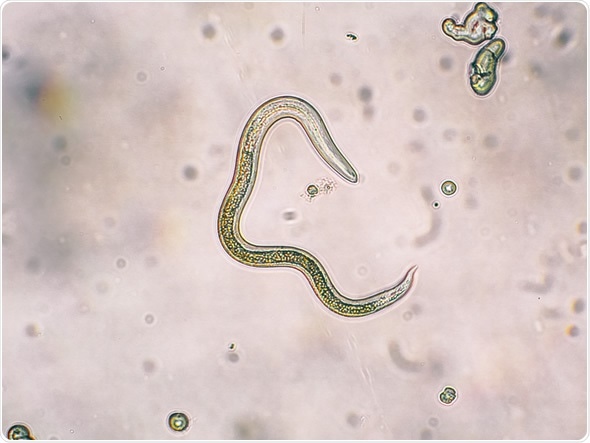Toxocariasis is an infection by roundworm larvae from dogs (Toxocara canis) and cats (Toxocara cati). Roundworm eggs from the dog and cat feces are common in soil and sand at parks, public beaches, and other outdoor environments.
In its normal life cycle, the roundworm eggs are ingested by another dog or cat and the larva migrate through the gut wall. Adult worms develop in the small intestine and deposit their eggs to be excreted with feces where they will once again become infectious in the soil.
Humans are not a natural host, but may become infected by accidentally ingesting eggs from the soil. The larvae hatch and penetrate the intestinal wall, traveling to other parts of the body like the liver, heart, and brain. In humans, the larvae do not develop into mature worms and lay new eggs. However, they do cause illness. There are three generally recognized syndromes.

Toxocara canis second stage larvae hatch from eggs - Image Copyright: olgaru79 / Shutterstock
Types of Toxocariasis
Covert toxocariasis is found in children. It causes a mild illness with fever. Other possible symptoms include cough, poor sleep, headaches, and abdominal pain. Children may show signs of infected lymph nodes, a swollen liver, or wheezing. Covert toxocariasis is thought to be caused by long-term exposure to migrating juvenile worms.
Visceral larva migrans (VLM) is an inflammatory reaction caused by the death of larvae migrating through the internal organs. It primarily affects children under the age of five. A range of symptoms are connected with VLM:
- fatigue
- weight loss
- anorexia
- fever
- cough
- pneumonia
- bronchospasm
- abdominal pain
- headache
- rash
- seizures (rarely)
A swollen liver, infected lymph nodes, and wheezing may also be present. Serious complications can develop, such as pleural effusions, chronic urticaria (hives), myocarditis, and respiratory failure.
When the larvae migrate to the eyes (ocular larva migrans), they can cause problems with vision, red eyes, or a white appearance of the pupil (leukokoria). Chorioretinitis—an inflammation of the vascular coat and retina—and granulomas are typical observations on examination. OLM can cause loss of vision, retinal fibrosis, retinoblastoma, and retinal detachment.
OLM is most commonly found in children between five and ten years of age.
Diagnosis of Toxocariasis
VLM should be suspected in any child with an unexplained febrile illness and eosinophilia (an increase in a type of white blood cell). Multisystem disease, a swollen liver, and a history of eating dirt are other signs that the child may have VLM. For OLM, unilateral vision loss and strabismus (misalignment of the eyes), are key symptoms.
A definitive diagnosis of VLM can be made by testing for common roundworm antigens and blood group substance A. However, these immunological tests are not reliable for OLM because patients tend to have lower levels of the roundworm antigen in their blood. OLM is diagnosed through an ophthalmologic exam.
Treatment
The standard treatment for toxocariasis is a five-day course of albendazole. This is sometimes supplemented with corticosteroids to suppress the allergic reaction to the roundworms. For OLM, surgery, steroids, and anthelminthic (anti-parasitic) chemotherapy are the preferred methods of treatment.
Further Reading